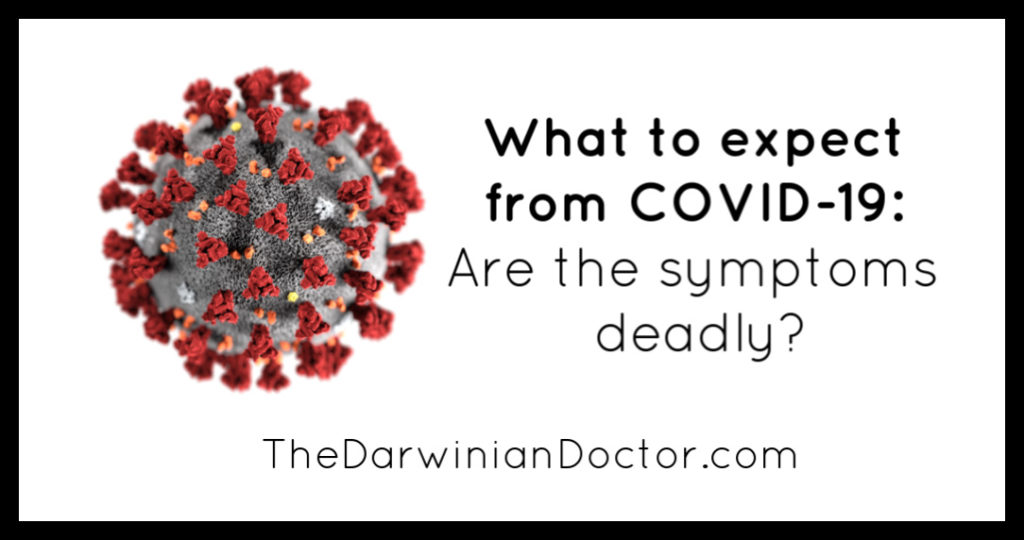OK, maybe you have a cough, but do you have COVID-19? In this post, I’ll go through the typical symptoms of COVID-19. I’ll explain when you should seek medical care and discuss how likely you are to die if you get a critical infection.

In my last COVID-19 post, I discussed in plain language how this novel coronavirus is different from the regular seasonal flu. To summarize, it’s twice as infectious as the flu. In the USA (as of March 2020), it’s about 15 times as deadly and kills about 1.5% of its victims.
But what is exactly making it so deadly? And what can you generally expect if you get COVID-19?
The CDC website isn’t that helpful in answering these questions. It only lists three symptoms: fever, cough, and shortness of breath.
I get it. They want to focus on the major things. But if you want to know more symptoms of COVID-19 and why it’s so deadly, please read on.
The best data is from China
The best data we have to answer this right now is from China. The COVID-19 disease originated in Wuhan, China, and spread locally there first before escaping to the entire world. Thus, they have the most robust data on what’s in store for the rest of the world.
Most of the information below is from an article published in JAMA (The Journal of the American Medical Association). The researchers analyzed over 72,000 Chinese patients to come to their conclusions. 95% of the patients were between the ages of 20-79 years of age.
So if you’re reading this blog, this data probably applies to you.
As an important caveat, only 62% of these patients were proven to have COVID-19 based on a formal test. The rest were assumed to have it based on exposure, symptoms, and signs like lung findings on a chest x-ray. Why didn’t everyone get a test? Because like in the USA, there weren’t enough tests to go around.
81% of people will get mild symptoms
There’s some good news here. The Chinese data suggests that 81% people will only get “mild” symptoms from COVID-19. These symptoms are still pretty awful, though, and start on average 5 days after exposure.
“Mild” symptoms can include (in no particular order):
- Fever
- Dry cough
- Fatigue
- Body aches
- Nausea and loss of appetite
- Losing your sense of taste or smell
- Diarrhea
You’ll notice that most of these symptoms are typical of a bad cold or the seasonal flu. This makes it a pretty nerve-wracking time to get sick with a cold.
Diarrhea is an unusual symptom that seems to have a strong connection to COVID-19. Early data out of China shows that diarrhea was seen in about a third of patients with COVID-19. For some people, diarrhea or abdominal pain was their most noticeable symptom of infection.
The loss of taste and smell is another unique symptom of COVID-19 that is being reported in the UK, Germany, and South Korea. Interestingly, 30-60% of patients may have only this symptom. Later when we have more test kits, this symptom might be a trigger to check to see if someone is an otherwise asymptomatic carrier of COVID-19.
If you have a combination of these symptoms and are concerned, it’s definitely OK to inquire about a COVID-19 test. However, availability of tests (as of late March 2020) is still low. Some health systems still don’t even have enough to check those who pretty clearly have COVID-19. So you may or may not be able to get a test.
Most people with mild symptoms will be fine to self-isolate and recover at home. But look out if your symptoms start to get more severe.
14% will get severe symptoms
In the Chinese research, severe symptoms were defined as breathing problems that required hospitalization and oxygen. Specifically, these symptoms were shortness of breath, having a low oxygen level, or breathing too quickly.
Basically, if you develop any breathing problems, you should go immediately to the emergency room for evaluation.
If you’re infected with COVID-19, the virus can cause damage to your lungs to make it hard to properly oxygenate your blood. Mild damage might not even be noticeable, but severe damage can cause your oxygen level to drop to dangerously low levels.
In the hospital, severely ill patients can expect to need oxygen and close monitoring until they either improve or become critical.
5% will be critical
The Chinese found that 5% of their COVID-19 patients were so sick that their life was in immediate danger from respiratory failure, septic shock, or organ failure. These are the patients in our hospitals now taking up the precious ICU beds. Half of the critically ill will need to be on a ventilator. These are the breathing machines that mechanically assist in breathing.
They’re in such short supply that some hospitals are now hooking up two patients to one ventilator.
In addition to lung damage, critically ill patients may have such severe infection that their blood pressure becomes too low to circulate blood to their organs. This is called septic shock, and is quite deadly.
There’s also emerging evidence that COVID-19 can cause heart damage to the point where the heart loses its ability to pump blood through the body. Current thought is that this is from severe “cytokine storm,” which is the body’s inflammatory reaction to infection. This reaction can lead to quick death in otherwise stable patients.
Unfortunately, if you get critically ill from COVID-19, the Chinese data says you will probably die.
In one early study of 52 critically ill COVID-19 patients from Wuhan, 81% of the patients who needed a ventilator died. The overall death rate in the critically ill patients was 62%.
Conclusion
Well this post got pretty depressing and scary. Sadly, that’s the reality of this pandemic.
If you take this article along with my previous post about the exponential spread of COVID-19, you can see why the medical community across the world is so terrified of this virus. Combine a 62% death rate in the 5% of critically ill patients with the rapid spread that is possible from this virus, and you’ve got a crisis.
Severely and critically ill COVID-19 patients are going to take up lots of resources like hospital beds, ventilators, and personal protective equipment. Also, they’ll require more and more doctors and nurses to care for these patients. The surge of COVID-19 patients is already stretching hospital resources to the breaking point in Washington state and New York City.
For once, it’s not just about the cost of caring for patients. It’s the harsh reality that currently, we literally don’t have the space and equipment to care for all the patients that are projected to need them.
I sincerely hope the medical community will be able to rise to meet the demand.
— TDD
The COVID-19 pandemic is a fast and fluid situation. My research and statistics are up to date as of the publication date of this post. Please share, comment, and subscribe for more content.
Please follow your local and state recommendations on social distancing and restrictions on gathering.
References:
- JAMA article: Characteristics of and Important Lessons From the Coronavirus Disease 2019 (COVID-19) Outbreak in China
- Clinical characteristics of COVID-19 patients with digestive symptoms in Hubei, China
- ENT UK: Loss of sense of smell as marker of COVID-19 infection
- JAMA Cardiology: Association of Cardiac Injury With Mortality in Hospitalized Patients With COVID-19 in Wuhan, China
Resources
- COVID-19 basics: Why it’s so much worse than the flu
- It’s working! How social isolation is flattening the COVID-19 curve
- The CDC: About Coronavirus Disease 2019 (COVID-19)
- Johns Hopkins: Worldwide COVID-19 Case Dashboard
Other popular posts
- My Why: family, friends, and freedom
- Update on the Rental Empire: Anno Darwinii 0.5
- What is moFIRE (morbidly obese FIRE) and why do I want it?
- Why I’m investing in real estate over stocks – Part 1
- Rental houses vs. stocks: a 25 year portfolio projection

